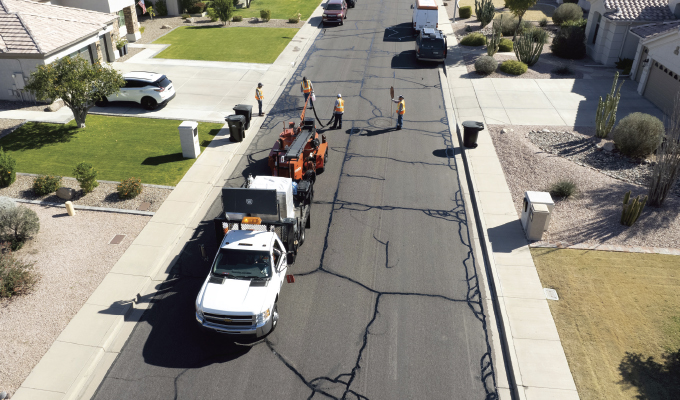A stitch in time saves nine. That 17th-century proverb sums up the City of Tempe, Arizona’s strategy for keeping its streets in the best possible shape without running into a budgetary dead end.
“My biggest thing is pavement preservation—keeping the new streets good—because once they go bad, it’s very difficult to bring them back to the level that they need to be within budget,” says Ed Bond, the senior civil engineer who supervises the city’s pavement management.
In fact, the city estimates that preservation is so much cheaper than major rehabilitation or replacement that it can maintain four to 10 times more streets than if fixing bad roads was the higher priority.
Each street—most of which are asphalt—is assessed every 3 years using a specialized vehicle equipped with imaging technology and sensors that look for problems such as cracks and potholes. That information is used to assign a pavement quality index (PQI) score for each street in the city’s 1,241-lane-mile network, which equates to 532 centerline miles. Those scores are fed into Stantec’s RoadMatrix software to create deterioration curves for each segment, enabling Bond’s team to identify the ones that are good candidates for pavement preservation.
FINDING THE RIGHT CRACK SEALER
Crack sealing is a key part of Tempe’s preservation program. The city’s go-to sealers are Crafco’s PolyFlex hot-applied products designed for asphalt or Portland cement concrete pavements. Crafco PolyFlex comes in several types designed for different climates. They are designed to resist cracking in the winter temperatures and bleeding or tracking in the hot summer months. The exceptional performance of this sealant comes from the unique properties achieved with the combination of recycled rubber, polymer, process oils, viscosity modifiers, and select asphalts.
Asphalt acts as the foundation and binder in the sealant, while process oils keep the asphalt “young” and prevent it from becoming brittle. Rubber provides flexibility and acts as a “sponge” that keeps the process oils in the mixture. Meanwhile, polymers add elasticity and recovery to compensate for thermal expansion and contraction. Viscosity modifiers are used to achieve the right resistance to flow, depending on the conditions. Crafco developed this technology over decades of experimentation and helped create the ASTM specifications used today.
“The PolyFlex Type 3 is used on local/collectors, and Type 4 is used on arterials,” Bond says. “Type 4 can withstand higher temperatures and correlates with the extreme heat experienced on our busier arterial roadway system.”
Both types are based on asphalt rather than reclaimed rubber, so they’re much more resistant to flow and pickup in very hot climates—a major plus in Tempe, where the average temperature is above 100 all summer. They also resist cracking in the winter temperatures, which can dip to freezing in Tempe.
Bond says Tempe’s hot, dry weather leads to pavement deterioration like brittleness, which increases the likelihood of cracks.
“Usually, it starts out with the initial transverse and longitudinal cracking. If we don’t crack seal it within the first 3 to 5 years, then eventually it turns into potholes.”
Bond’s team particularly likes the way PolyFlex performs, especially after the first year.
“Crafco is required to give us at least a one-year warranty for the full product,” Bond says. “After that, it’s on us to watch it. We’ve seen good performance even after the one-year initial application.”

PREVENTIVE MAINTENANCE
Tempe’s success with crack sealing has helped Tempe’s transportation department get the funding it needs to maximize preventive maintenance.
“We have the history of what’s been done; we’re able to use the software to predict where we’re going,” Bond says. “Then we can go to our budget office to say, ‘Based off of the allocations that we’ve been receiving, this is where we’re going, and this is what we would like to do going forward.’ It helps tremendously.”
Crack sealing also helps the city meet the goals of its Tempe Accelerates program, whose initiatives include creating a safe and secure community, improving quality of life, achieving sustainable development, and more. For example, the Refresh Tempe initiative focuses on quality-of-life goals such as rehabilitating and maintaining roads.
“Tempe’s pavement quality is a Council priority that has been identified for acceleration, allowing the city to reach its goal of a PQI of 70 by 2028, due to increased budgetary funding,” the city said in a September 2022 press release describing the 20 projects scheduled for fiscal year 2023.
The city traditionally plans road improvement projects over a 5-year period, but Tempe Accelerates adds flexibility.
“In the past, we would just get a standard amount of money on a yearly basis, and there wasn’t really much room for changing that because it was always a 5-year plan,” Bond says. “But Tempe Accelerates gave us the ability to ask for increases over and above what the standard budget amount was.
“It has worked out great,” he says. “Besides the one year we went through COVID reductions, we’ve pretty much almost doubled our pavement budget amount on the yearly basis.”
CLOSING THOUGHT
All of these benefits highlight the importance of having not only a diligent crack-sealing program, but also one that uses a high-quality, high-performance sealant. For Tempe, Crafco PolyFlex sealant has proven to be the ideal choice for ensuring that the city’s drivers can look forward to smooth roads.
For More Information:
For more, visit crafco.com.
Modern Contractor Solutions, June 2023
Did you enjoy this article?
Subscribe to the FREE Digital Edition of Modern Contractor Solutions magazine.



